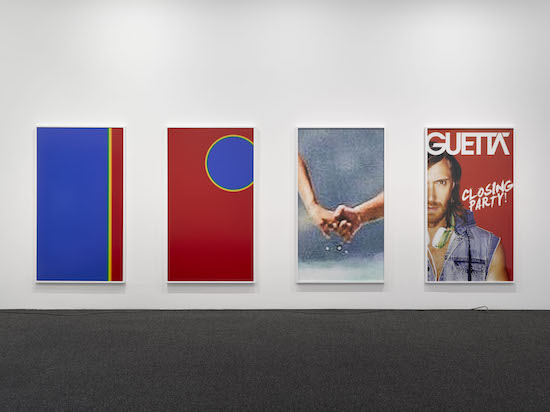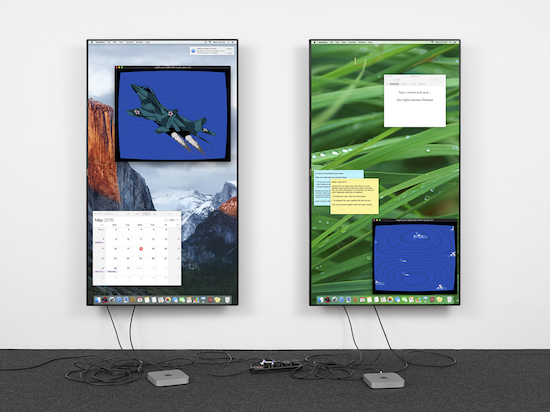Mig 29 Soviet Fighter Plane, Clouds and OSX, 2016. Mig 29 Soviet Fighter Plane and Clouds (2005) Nintendo Entertainment System.nes Roms, Two Macminis running OS X, Nintendo emulators (Open Emu), variable multi-channel presentation. Dimensions variable. Photo by Jack Hems © Cory Arcangel; Courtesy of Lisson Gallery
It’s a little after six pm and the Lisson Gallery is pumped. As people mingle about the private view holding glasses of white wine, making small talk or gazing at the work on the walls, a festival-style hanging speaker array is blasting out a ceaseless flow of sidechained white noise. It’s like an EDM drop that never quite arrives, a persistent build-up of tensions never released. The effect, in fact, is peculiarly Wagnerian, like the endless deferral of tonic resolutions to the dissonant intervals in the Tristan und Isolde. Time is held in suspension, teetering on the brink of who knows what.
It may sound like an odd comparison. After all, this is the opening night of a new solo exhibition by Cory Arcangel, the renowned New York post-conceptual artist, famous for his video game modifications, YouTube cut-ups, and Photoshop abstractions. But Arcangel’s studies at Oberlin Conservatory in the late 90s were in electronic music. “Probably more than any other way to access my work,” he says, speaking of his current practice, “composition would be the one that would make the most sense the most amount of times.”
A case in point: Since 2011, Arcangel has maintained a collection of 839 trance records, purchased from the former DJ, Joshua Ryan. In 2015, I saw this collection, the AUDMCRS Underground Dance Music Collection of Record Sound, presented at Thadaeus Ropac’s gallery in Pantin, on the outskirts of Paris, meticulously catalogued and preserved in the manner of any other serious and worthy archive of historical material.
For the opening night of the show in Pantin, in the summer of 2015, Ropac had arranged for the Ensemble InterContemporain, the chamber orchestra founded by Pierre Boulez in 1972, to perform in the warehouse which housed Arcangel’s installation. Arcangel had one of the soloists, a viola player named Grégoire Simon, perform a historically informed DJ set with the trance collection.
In the world of early music, historically informed performance (sometimes abbreviated as HIP) is a doctrine with its origins in the late nineteenth century stressing the importance of authenticity and period accuracy in the presentation of pre-modern musical styles. With just as much seriousness and attention to detail as a concert of Frescobaldi harpsichord variations played on a period instrument at historically accurate pitch and tuning, on the 7th of June 2015, Grégoire Simon performed a 45 minute trance set on two Technics turntables before a well-dressed audience, seated, with programme notes.
“My composition called for a performance with a certain set of variables,” Arcangel explains of the performance. “It had to be these kind of turntables with this kind of sound system, this length, with these records. And I worked with the soloist all week long. We rehearsed for a couple of hours a day to get the set just right.” He speaks with all the fervour of a true HIP devotee. “Because you can’t actually see trance music performed historically correct anywhere anymore. Clubs don’t really have turntables. People don’t have those records. And there is a difference between CD-DJs and classic vinyl,” he insists, before adding, “And some of the records in that collection are just straight bangers.”

Installation view. Courtesy of Lisson Gallery
I’m talking to Arcangel via Skype to his co-work space in Stavanger, Norway. He’s in the phone room, which, with its egg-boxed walls, looks a little like a recording studio, or perhaps Thomas Newton’s spaceship in The Man Who Fell To Earth. It was in a similar kind of lab called Eyebeam in New York City, back in the early 00s, that Arcangel first encountered a man who would have a profound influence on one of the more oblique aspects of his current show at the Lisson, and, indeed, on the whole online world. “I had a desk at one end of the lab,” Arcangel explains, and at the other end of the lab, at a similar desk, was Jonah Peretti.
Arcangel would end up as one of the first editors on Peretti’s groundbreaking website Buzzfeed, even as he was already gaining recognition for works like 2002’s Super Mario Clouds (a hacked Nintendo cartridge that removed all the characters and landscapes, leaving just a scrolling backdrop of fluffy clouds against a blue screen), 2007’s A couple thousand short films about Glenn Gould (a supercut of single notes from a multitude of YouTube clips edited to play the first variation from Bach’s Goldberg Variations), and The Bruce Springsteen Born to Run Glockenspiel Addendum (a vinyl record of glockenspiel melodies to be played simultaneously with the Boss’s seminal third studio album of 1975).
“When I was at Buzzfeed,” Arcangel recalls, “Jonah just kept saying do lists. Lists, lists, lists. And I could never understand what he was saying. But now I understand what he was saying.” He has retained, ever since, a fascination with the peculiar flora and fauna of the web, what he calls “the flipside of technology. On one side you have a Tesla car and on the other hand you have clickbait.” back in 2011, Arcangel did a show at the Whitney Museum in New York and had Buzzfeed’s ad team make a series of ads for it. For his show at the Lisson this year, he’s arguably gone a shade darker.
“We’re running a campaign on Outbrain,” he tells me. Outbrain describes itself as a “content discovery platform”. “You know,” Arcangel explains, “like, when you’re on a blog or the New York magazine, and under the blog, there’s like, ‘more from the web’. So we’re taking out an advertising campaign in one of the companies that does those things which will then re-present some of the images from the show in that context, which is spread all over the web, with very clickbaity titles, like ‘eight out of nine Americans wont believe this fact’. You know what I mean? ‘29 Things to do blah blah blah’.”
People have often described Arcangel’s work in terms of nostalgia. Super Mario Clouds and other similar arcade game modifications have been linked to a kind of fetishism for retro-tech. But that is not Arcangel’s own angle on it. “When I started working with [Nintendo games], they were just considered trash. They weren’t considered nostalgic. Because they were not yet considered important. They were cheap. They were invisible to culture.” Arguably, clickbait performs a similar function today: cheap, pervasive, immediately recognisable, yet largely unexamined, ignored by high culture.
Which is why it makes sense to think of Arcangel’s work, even when it’s a still image in a frame on a wall, in terms of music. “It deals with time and deals with culture and deals with fashion. And that’s all time-based. So I would say that my hyper-awareness of time – which is what composition is – informs the work and is propping a lot of it up. Because a lot of my work is basically about time. Things going in and out of fashion. Things decaying. Things becoming unorganised, things getting organised.”
Cory Arcangel’s Currentmood is at the Lisson Gallery until 2 July


